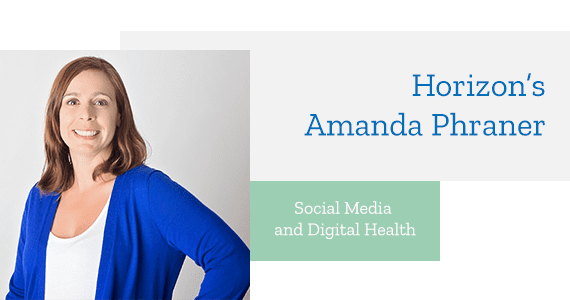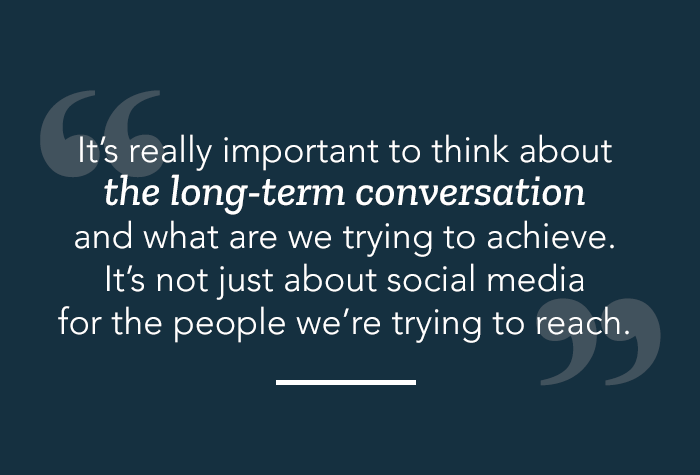
An Interview with Horizon’s Amanda Phraner – Social Media and Digital Health – August 2018

Mark Bard: I’d like to introduce Amanda Phraner from Horizon Pharma. She has a great history of working both on the client side and the pharma side. We’re going to go through a couple of questions about some of her experience within social media, some of the challenges, obstacles she’s seen and some of the opportunities she sees going forward. First, we would love to hear some of the key lessons you learned after being on the agency side, working with multiple clients, and seeing how different companies would approach things. And, how has helped you when you went and made this move to Shire and now at Horizon?
Amanda Phraner: I think after a decade on the agency side, I thought I knew everything going into the client side, but discovered many more lessons to be had. Some of the key things from the agency side: the ability to work with multiple clients and multiple people, multiple industries, for me, was that inspiration can really come from anywhere. Sometimes we get so mirrored in our industry and we’re always looking for the next big thing there. We’re not exploring outside. Some of the best ideas that came forward when I was on the agency side working with clients came from outside of healthcare.
There was one opportunity where we really wanted to spotlight the role that fathers played in preventing medicine abuse for a blog that was really mostly about moms talking. That idea actually had come from something that Home Depot was doing to honor dads for Father’s Day. Looking outside is key.
I think the other thing is taking the time to learn from others. I got to work with a number of skilled specialists, whether it was in paid media or a creative director, and while I will never, ever claim to be an expert in any of that, it was a real opportunity to see what they were doing and see how it could come together for the bigger picture. I take that with me as I now work with regulatory, and legal, and medical affairs and research and development. I will never be an expert in those areas, but they help really shape the programs that we can bring together.
Then, of course, keeping focused on what matters. It is so easy to get distracted in the day-to-day but being able to stay focused on that. I think being on the agency side with multiple clients, multiple asks, it’s how you keep moving things forward.
The last thing I will say, is don’t be afraid to go for it. I think on the agency side, we’re always pushing and really trying to find new ways to do things and carrying that over, not being afraid to go for that big program, bring everybody together around it, and really focus on it.
MB: We’ve talked a little on Horizon, and some are familiar with the company; some may not be as familiar. When you look at this, it is a very unique company. Some of the keywords that come out from the website: “patients”; “outcomes”; “unmet needs”; and that really does lend itself to this idea of social media. It’s an enabling technology, not just at the corporate level but at their brand level, as well. When you think about social media, is this about connection in the truest sense, or is it really about education and trying to get to that point of connection with a patient? Where are we at today as you see it sitting at Horizon?
AP: It is a unique company. That’s what drew me here. I’m going to answer your question with a yes, it’s both. I think for social media, I have the opportunity to work in rare diseases, some of which have less than 1,000 people who live with it. A lot of times, it’s education because there’s not a lot of information out there, and education becomes the first door to connection. It’s really about being authentic, being in the moment, and getting to true sense of interaction. The beauty of social media is it breaks down geographic barriers, particularity in rare disease where somebody living with it may never meet somebody else except for the opportunity to connect on social or maybe go to an in-person event. They’re not going to have a neighbor who understands what they’re going through.
We open the door with education. It’s a nice way for somebody living with it to also share with their friends and family. Often times, they’re actually the experts. Their physician may not have ever seen anybody else like them. We have that ability to provide those resources and help really further awareness and understanding. That really comes down to the interaction, the connection. How do we foster that? How do we help the people who are coming to our communities connect with one another and how do we provide the right support as the community managers of the social channel.
MB: Looking at the technology and opportunity of live video and something like Facebook Live – we see big networks doing it, we see brands doing it, companies doing it. You yourself, earlier this year as part of the Aspen Ideas event, did a Facebook Live broadcast. What did you learn from that? How are we learning that Facebook Live fits into a broader social strategy?
AP: We’re still learning. We actually piloted Facebook Live last year for the first time at Global Genes on their blue carpet. It was an interesting opportunity to think about live video and the way people think about being live from the red carpet and doing interviews. It was also an easy foray into it and a pilot that we could really talk to our compliance and regulatory teams with. That’s one of the things about working in healthcare is how do we do something, but how do we test the waters in a way that we all feel comfortable and confident to move forward. That really went to being able to do Facebook Live at the Aspen Ideas fest. It also built upon this concept that we had been testing for our Horizon corporate Facebook page, which was how do we bring activities that are happening to audience who may not be there.
With the Aspen Ideas fest, we had hosted a round-table, and we took that opportunity to bring insights from that conversation to our followers and fans on the page. We’re still working through a lot of the technology challenges that present. How do you make sure people get the notifications? How do you make sure to promote the event in advance? What are the right times that fit with the ability to be live in the moment in people’s schedules and when people might be able to tune in?
One of the beauties about Facebook is that you can, like this webinar, record it and re-share it out because things always come up. We’re really able to reach more of an audience interested in healthcare, interested in learning more about rare diseases, interested in the industry overall.
MB: Backing into some of the strategy of social is this evergreen idea that there’s a short-term focus on social and then there’s this need to have the long-term engagement. Everyone loves the cocktail party analogy. You can come in and make a lot of noise and get that initial engagement, but now you’ve got to carry a conversation, which it seems some brands have some issues with. What is that balance between the two? Is that just something that that’s the nature of social? How do you think about that balance between coming out strong and doing the initial engagement and keeping that going over time?
AP: It’s the nature of social even if you think about the way you personally use channels when something comes out. You’re really excited and then you maintain it. For us, for thinking about it with the community, it’s really important to think about the long-term conversation and what are we trying to achieve. It’s not just about social media for the people we’re trying to reach. It’s just one part of the conversation. One channel in which they’re having that conversation with us and they’re not seeing it separate from any conversation they’re having in person or over the phone or via email. It’s the conversation continuum.

I think the biggest thing that I’ve seen value in in terms of maintaining the long-term view of the strategy is the ability to know what you want to say no to in terms of messaging and timely opportunities. There will always bethose moments in which you want to look at something that doesn’t necessarily fit with where you’re trying to do and needing to keep that long-term vision and that eye on what you’re trying to do.
That said, we put a lot of effort into metrics and reviewing what’s resonating, what’s really important for us. We work in small rare diseases. I really never want to see a post that gets a million views because it means I didn’t reach the right people. I want to see a post that tags other people and says you should watch this because it’s exactly what I’m going through, or you should download this resource; it’s really helpful. Or thank you for sharing this; this is exactly how I feel. Those are the things we look for and try and understand why it worked, what worked.
As Brad [Einarsen, Klick Health]
had shared on the posting cadence, we try and figure that out. What’s too much; what’s too little; what’s the right balance that you feel like you’re an authentic part of the community and that’s the way your content’s being – it’s really thinking about that long-term commitment when you launch. That’s sometimes hard because it’s easy to think through the first six months, maybe the first year, but as the plans come around to the next year, it’s important to remember what you’ve built, what you’ve learned, and how to really continue that to the people that you’re trying to engage. I think keeping those people at the center of what you’re doing helps keep that long-term strategy in focus.
MB: That was a really interesting example of we’re not thinking just likes if you’re saying you’re targeting 500 to 1,000 people. It’s “am I hitting that right audience within that?” That really is the true test of success. Taking social to the next level, how is customer service within social relevant to pharma? If we think about what is the patient as it relates to a pharma company and not interfering with the patient/physician relationship. Where’s customer service come in, and where does social cross over to that intersection, given the deep focus Horizon has on patients?
AP: Customer service, patient engagement for us are almost sort of the same. A lot the people we try to help, it’s not just about the medicines they take. It’s the useful support they need for the rare disease they’re living with and for the chronic nature of that. The opportunity to be available when and where they need you is something interesting for social. I think that growing trend we’ve seen and sort of that quiet private social media, if you think about Facebook Messenger, private messages, I think that will open more doors in terms of how patients seek out and get support.
A lot of times questions don’t necessarily want to be asked publicly, but then they send a message and say, “I need help understanding X,” or “Can you connect me with the right physician who understands my disease, especially in rare disease?” “Can you provide me resources for 504 IEP plans because my child is going back to school and I need to make sure that they’re set up to succeed.” I think if we really think about what the people are trying to serve and help are looking for, we can think about ways in which we can support that.
Some of it’s also just even looking at “how do we tell more stories? Do people want to share? What’s their opportunity to connect in with us?” Not everybody wants to email; not everybody wants to pick up the phone. These Messenger apps and tools really provide a unique way for people to reach out in the platform they’re on when they’re seeing content and in the moment they have the question.
MB: One last question: you’re incredibly busy with social media. You’re incredibly busy with a lot of stuff you’re doing. You’re also an avid triathlete. For everyone out there trying to stick that balance between professional and personal, and health is absolutely part of everything we do, how do you find time for a triathlon and everything you do outside of pharma?
AP: What’s the old saying? “If you don’t have time for a 30-minute run, go for an hour.” We’re all really busy, and I think we all find the things in our life to find balance. For me, I prioritize getting out and swimming, biking, and running, and answering that very, very early alarm when it goes off at 4 AM because that’s when I’m unplugged and actually that’s when I can think freely, and some of my best ideas come at those times, when you’re not staring at computers or TVs or talking to people and you’re just free to think.
I’ve many times walked into a meeting with, “I had this really great idea while I was swimming!” The other side of it is I generally go to bed probably about 9:30 because 4 AM comes really early. It’s important; it helps me be better at what I do, and so I really just block off the time on my calendar and make it something that’s a priority. I also find that if you do it in the morning, you can’t get caught up with that last-minute meeting or email because nobody really wants to meet up at 4 AM.
